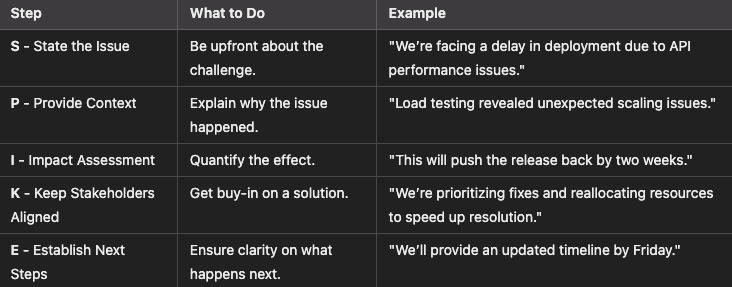Status Reporting for Engineering Managers
Communicate Clearly, Build Trust, and Avoid Micromanagement

Status reporting isn’t just about tracking progress, blockers, and risks—it’s about keeping your team aligned, managing leadership expectations, and proactively communicating challenges before they become crises.
Done well, status reporting builds trust and transparency. Done poorly, it leads to misalignment, unrealistic expectations, and last-minute fire drills.
One of the most common EM interview questions is:
"How do you handle status reporting and communicate risks to leadership?"
This post will break down:
✅ The different types of status reporting EMs must master.
✅ How to deliver bad news without causing panic.
✅ A simple, reusable status report template you can apply immediately.
Let’s get started.
1️⃣ The Role of an Engineering Manager in Status Reporting
An EM’s status reporting responsibilities include:
🔹 Monitoring Project Progress: Keeping an eye on timelines, bottlenecks, and resource constraints.
🔹 Communicating Upward: Ensuring executives and stakeholders get the right information, not just raw data.
🔹 Managing Team Expectations: Balancing transparency while reducing the reporting burden on engineers.
💡 Think of EMs as the translators—converting complex technical updates into clear, actionable insights for leadership, without overwhelming engineers with status check-ins.
2️⃣ The 3 Types of Status Reporting EMs Need to Master
1. Team-Level Reporting (For Engineers & Internal Team Syncs)
Goal: Track progress, identify blockers, ensure smooth execution.
Format: Daily standups, async Slack check-ins, sprint retrospectives.
Key Question: “Are we making steady progress?”
📌 Best Practices:
✅ Keep standups lightweight. Engineers should spend less than 5 minutes per day on reporting.
✅ Focus on blockers, not just updates. Example: “I’m stuck on a dependency with X team. Need help to resolve it by EOD.”
✅ Use tools like JIRA, Linear, Notion, or GitHub Project Boards to automate reporting and centralize updates.
💡Slack Standup Format:
🟢 What I accomplished yesterday: Helps track daily progress.
🔵 What I’m working on today: Ensures visibility into ongoing tasks.
🚨 Blockers or help needed: Prevents delays by surfacing issues early.2. Cross-Team Reporting (For Product, Design, and Other Teams)
Goal: Keep stakeholders aligned across functions (Eng, Product, Design, Business).
Format: Weekly syncs, async Slack updates, shared dashboards.
Key Question: “Are we working toward the same goals, and do we see dependencies early?”
📌 Best Practices:
✅ Use RACI charts to clarify cross-team ownership (Responsible, Accountable, Consulted, Informed).
✅ Create shared dashboards in Notion, Confluence, or Google Sheets—avoid information silos.
✅ Translate technical updates into business impact (see next section).
💡 Example: How to Use a RACI Chart in Cross-Team Collaboration
This ensures clear ownership and reduces miscommunication.
💡 Example Status Update (for Product Team):
❌ Bad: "API migration delayed due to refactor."
✅ Better: "API migration delayed by 1 week due to unexpected schema conflicts. No impact on upcoming launch, but requires an additional QA cycle."
3. Executive & Leadership Reporting (For Directors, VPs, and C-Suite)
Goal: Provide high-level insights, risks, and business impact updates to leadership.
Format: Monthly business reviews, OKR updates, project status decks.
Key Question: “Are we delivering measurable business value and mitigating risks effectively?”
📌 Best Practices:
✅ Keep it concise: 3–5 bullet points per update.
✅ Lead with business impact: "We're on track to improve latency by 30%, which supports our Q2 user growth target."
✅ Use the OKR framework to structure updates (Objective, Key Results).
💡 Example Leadership Update Format:
📌 **Project Name: Cloud Infrastructure Scaling**
🎯 **Objective:** Improve system resilience before peak traffic season.
📊 **Key Results:**
- ✅ 3/5 planned infra upgrades completed.
- ⚠️ Latency reduction tracking at 20% (goal is 30%).
🚨 **Risks:** Need additional load testing due to unexpected scaling issues.
📆 **Next Steps:** Complete remaining upgrades by next sprint & re-test.3️⃣ How to Deliver Bad News Without Panic
🔹 Bad Approach: "The project is behind schedule. We’re facing issues."
🔹 Better Approach: "We’ve identified a delay due to [X]. Here’s our proposed mitigation plan: [Y]. Expected impact: [Z]."
💡 The SPIKE Method for Delivering Bad News
📌 Pro Tip: Always frame risks with solutions and next steps—this builds confidence in your leadership.
4️⃣ Status Report Template for Engineering Managers
Weekly Status Report Template
📌 **Project Name:** [Insert Name]
🎯 **Objective:** [What problem are we solving?]
🏆 **Key Accomplishments:** [Milestones Achieved]
📊 **Progress Summary:** [Current status in 2-3 bullet points]
⚠️ **Risks & Challenges:** [What are the current blockers?]
📆 **Next Steps:** [What’s coming next?]Use this template in emails, Slack updates, or meetings to keep communication concise and structured.
Conclusion: EMs Who Master Status Reporting Build Trust & Influence
Key Takeaways:
✔ Make updates clear, concise, and impact-driven.
✔ Automate where possible—reduce reporting overhead.
✔ Frame risks with solutions and next steps.
📢 Your team is only as effective as your communication.
Mastering status reporting isn't about drowning in updates—it's about building trust, aligning stakeholders, and making sure your team can execute without roadblocks.
Want more insights on engineering leadership, communication strategies, and scaling teams?





